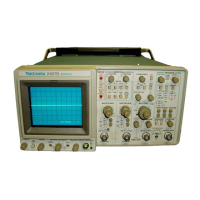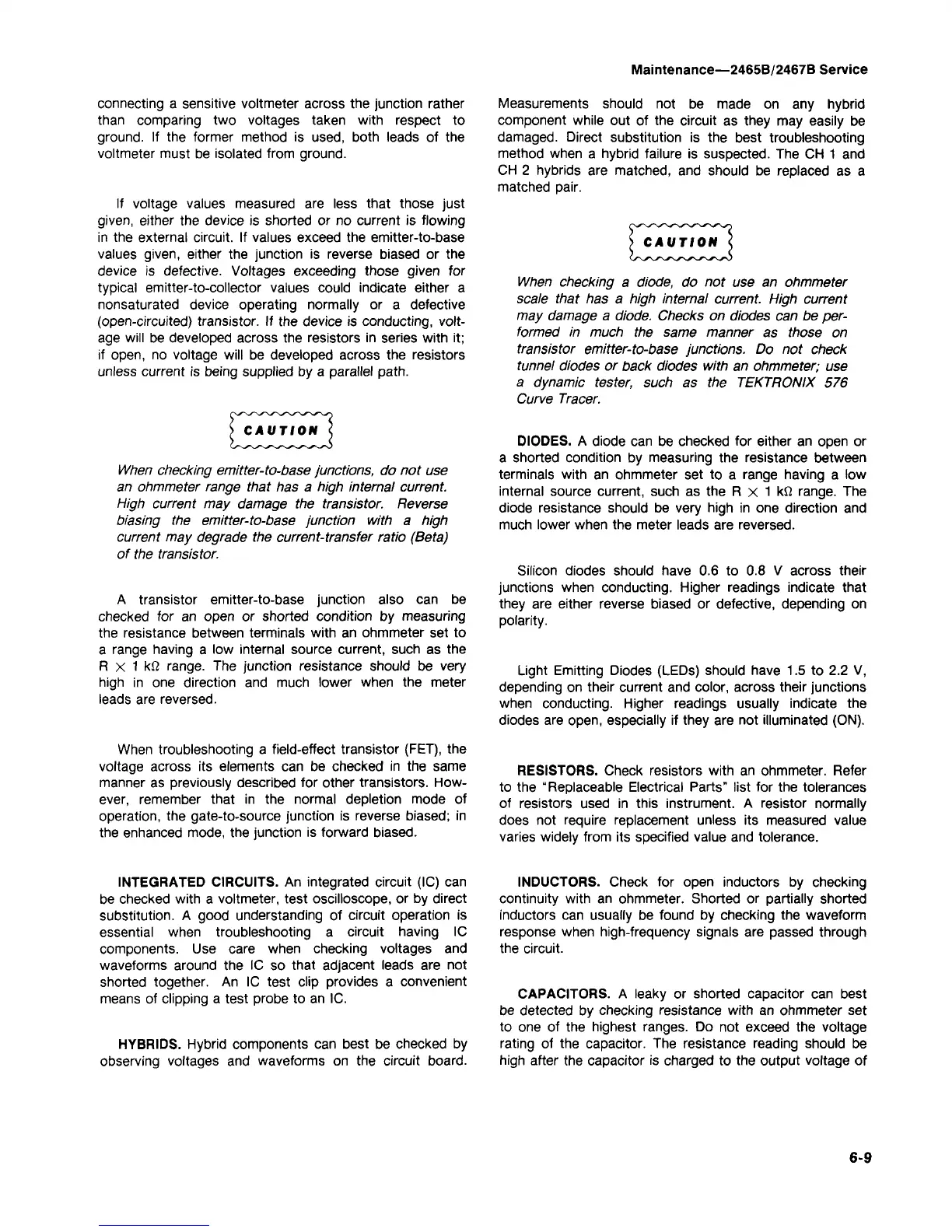Maintenance—2465B/2467B Service
connecting a sensitive voltmeter across the junction rather
than comparing two voltages taken with respect to
ground.
If the former method is used, both leads of the
voltmeter must be isolated from ground.
If voltage values measured are less that those just
given,
either the device is shorted or no current is flowing
in the external circuit. If values exceed the emitter-to-base
values given, either the junction is reverse biased or the
device is defective. Voltages exceeding those given for
typical emitter-to-collector values could indicate either a
nonsaturated device operating normally or a defective
(open-circuited) transistor. If the device is conducting, volt-
age will be developed across the resistors in series with it;
if open, no voltage will be developed across the resistors
unless current is being supplied by a parallel
path.
When checking emitter-to-base junctions, do not use
an ohmmeter range that has a high internal current.
High current may damage the transistor. Reverse
biasing the emitter-to-base junction with a high
current may degrade the current-transfer ratio (Beta)
of the transistor.
A transistor emitter-to-base junction also can be
checked for an open or shorted condition by measuring
the resistance between terminals with an ohmmeter set to
a range having a low internal source current, such as the
R x 1 kfi range. The junction resistance should be very
high in one direction and much lower when the meter
leads are reversed.
When troubleshooting a field-effect transistor (FET), the
voltage across its elements can be checked in the same
manner as previously described for other transistors. How-
ever, remember that in the normal depletion mode of
operation,
the gate-to-source junction is reverse biased; in
the enhanced mode, the junction is forward biased.
INTEGRATED CIRCUITS. An integrated circuit (IC) can
be checked with a voltmeter, test oscilloscope, or by direct
substitution. A good understanding of circuit operation is
essential when troubleshooting a circuit having IC
components. Use care when checking voltages and
waveforms around the IC so that adjacent leads are not
shorted together. An IC test clip provides a convenient
means of clipping a test probe to an IC.
HYBRIDS. Hybrid components can best be checked by
observing voltages and waveforms on the circuit board.
Measurements should not be made on any hybrid
component while out of the circuit as they may easily be
damaged.
Direct substitution is the best troubleshooting
method when a hybrid failure is suspected. The CH 1 and
CH 2 hybrids are matched, and should be replaced as a
matched pair.
When checking a diode, do not use an ohmmeter
scale that has a high internal current. High current
may damage a diode. Checks on diodes can be
per-
formed in much the same manner as those on
transistor emitter-to-base junctions. Do not check
tunnel diodes or back diodes with an ohmmeter; use
a dynamic
tester,
such as the TEKTRONIX 576
Curve
Tracer.
DIODES. A diode can be checked for either an open or
a shorted condition by measuring the resistance between
terminals with an ohmmeter set to a range having a low
internal source current, such as the R X 1 kfi range. The
diode resistance should be very high in one direction and
much lower when the meter leads are reversed.
Silicon diodes should have 0.6 to 0.8 V across their
junctions when conducting. Higher readings indicate that
they are either reverse biased or defective, depending on
polarity.
Light Emitting Diodes (LEDs) should have 1.5 to 2.2 V,
depending on their current and color, across their junctions
when conducting. Higher readings usually indicate the
diodes are open, especially if they are not illuminated (ON).
RESISTORS. Check resistors with an ohmmeter. Refer
to the "Replaceable Electrical Parts" list for the tolerances
of resistors used in this instrument. A resistor normally
does not require replacement unless its measured value
varies widely from its specified value and tolerance.
INDUCTORS. Check for open inductors by checking
continuity with an ohmmeter. Shorted or partially shorted
inductors can usually be found by checking the waveform
response when high-frequency signals are passed through
the circuit.
CAPACITORS. A leaky or shorted capacitor can best
be detected by checking resistance with an ohmmeter set
to one of the highest ranges. Do not exceed the voltage
rating of the capacitor. The resistance reading should be
high after the capacitor is charged to the output voltage of
6-9

